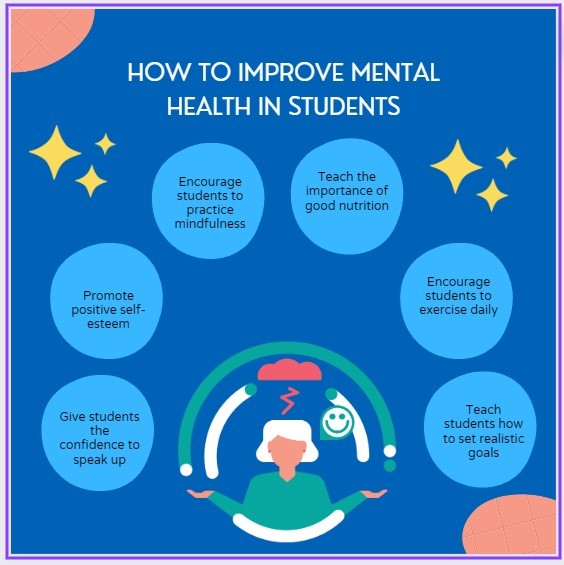How To Boost And Improve Primary Students' Mental Health And Wellbeing?
8th January 2024

Research reveals that 35% of students feel stressed at school and the cases of anxiety and panic attacks have increased to about 78% for primary school students.
The term ‘health and well-being’ typically refers to an individual's mental, emotional, and physical well-being. Whether they attend public or private schools, students spend 190 days a year in the classroom on average, so nurturing positive well-being needs to happen in educational settings. Therefore, the goal of health and well-being in schools is to promote mental, emotional, and physical health.
If you are a primary teacher looking for a transformative way to enhance and improve students’ well-being at school, look no further as here are some inspiring tips.
Practical Ways To Support Health And Well-Being Of Primary Students

Source: themanthanschool.co.in
If your students have behavioral difficulties that make it challenging for you to handle them and they are left excluded, here are some tips to help and support them:
- Invest In Mental Health And Wellness training
Teachers have felt compelled to provide more emotional well-being support for children and young people in light of the increase in mental health issues among students. Many education professionals struggle to keep up with the increasing workloads and lack of support because they don't think they have the necessary training. To counter this, educational institutions can offer teachers training programs.
It is crucial to create space in school settings for mental health specialists with specialized training. All educators should, nevertheless, believe that they have received enough instruction and assistance to help their students with their mental health and wellness. Additionally, designating student and staff ambassadors for mental health will raise awareness and establish a channel of communication between students and faculty.
- Advocate For Physical Activity
The benefits of physical activity to the body and mind are enormous. Maintaining an active lifestyle boosts mental alertness, which enhances focus and productivity. It also results in less stress, a happier mood, and more energy. Additionally, exercise releases endorphins, dopamine, and serotonin chemicals that affect mood and improve well-being by easing the symptoms of depression.
Schools can encourage regular physical activity by implementing active travel programs that support healthy and sustainable modes of transportation. Walking, riding, or scootering to work, school, or university has a big impact on mood and energy levels. In addition, offering staff and students subsidized gym memberships and classes can help encourage regular physical activity.
Hey, do you follow us on Social Media? We regularly share upgraded educational content, tips, feedback and more. Check us out by clicking the profiles here - Facebook / Twitter / LinkedIn / Pinterest / Instagram / YouTube
- Promote Mindfulness
By taking some time out of your day to unwind and re-establish a connection with yourself, mindfulness can help your students remain composed and grounded in adverse circumstances. Conducting a brief breathing exercise for the group during assembly is a simple way to incorporate mindfulness into the school day.
One of the key advantages of implementing mindfulness in your school is that it's usually inexpensive or free. You can get free tools and methods easily accessible via online searches.
- Offer Feedback Opportunities
The foundation of any school or university is made up of students and educators. They must be given the chance to influence decisions made about their welfare at the school as a whole. A few strategies for gathering feedback and making changes to the way things are done at schools and universities can make a huge difference.
This includes introducing one-on-one consultations with staff and students, conducting opinion surveys, choosing representatives from among students and teachers, and providing input on teaching and learning approaches.
- Make Wellbeing Fun
Wellbeing should not be boring if you want your students to understand and value it. Organize a school gardening project, take them outside for team games, or schedule an arts and crafts period during lunch. The secret to selecting an activity for students is to make it enjoyable and lighthearted, something they will want to do instead of feeling compelled to.
Asking your students for recommendations is never a bad idea because they are the ones who will know what they like best! If at all possible, try to vary the kinds of activities you host. Since not every student will be interested in every activity, having a varied program is essential to maintaining the engagement of the entire class.
- Stress On Extracurriculars
Enhancing your students' well-being through extracurricular activities is highly recommended. Children who participate in clubs or societies develop their social skills, stay busy and involved, and gain confidence in themselves. Providing a good mix of athletics, music, and artistic pursuits guarantees that the majority of your pupils will find something to pique their interest.
Reminding your students that money can be a major obstacle to their participation in after-school activities is important. Whenever feasible, try to provide a free option. If not, think about creating a bursary program for motivated students who are unable to pay the club fee.
- Improve School’s Physical Environment
Layout changes and technology advancements can be used to create functional spaces that enable teachers and students to be safe and productive. A good way to maximize space and get students back into the classrooms as soon as possible is to introduce multipurpose rooms with movable furniture that can be used for a range of staff and student needs.
Likewise, common areas like canteens, cafeterias, and areas for staff to refuel must be redesigned to accommodate the reintroduction of large numbers of students and employees. Touchless innovations can help create safe and hygienic environments. Touchpoints in hallways, school fountains, and elevators can be minimized by using contactless sensors.
Make Learning Fun Without Compromising Wellbeing
It is critical to support students' mental health and self-esteem in an educational environment that is always changing. Teachers can create an engaging learning environment for students by incorporating music and interactive activities. Furthermore, by offering a proper Certificate in Pre and Primary Teacher Training Course, schools can support the well-being of their staff and rethink learning where everyone benefits.
We believe education should be accessible for everyone. That’s why we don’t charge for our blogs. Find the right course that will help you in your career with us, contact us at - 1800-212-6400. You can mail us at act@asiancollegeofteachers.com
Written By: Sheetal Sharma